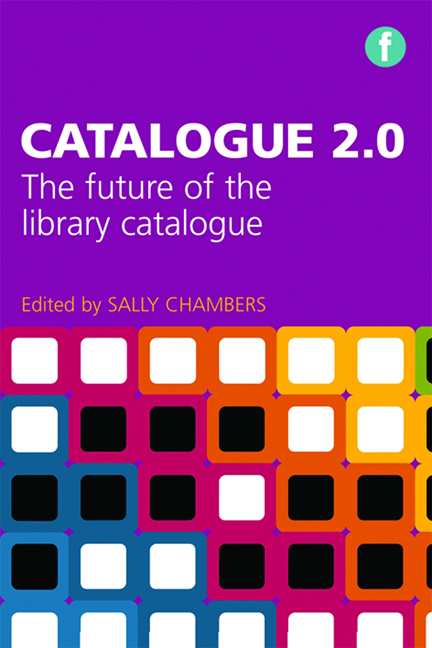Book contents
- Frontmatter
- Dedication
- Contents
- Acknowledgements
- Foreword
- Introduction
- Editor and contributor
- 1 Next-generation catalogues: what do users think?
- 2 Making search work for the library user
- 3 Next-generation discovery: an overview of the European scene
- 4 The mobile library catalogue
- 5 FRBRizing your catalogue: the facets of FRBR
- 6 Enabling your catalogue for the Semantic Web
- 7 Supporting digital scholarship: bibliographic control, library co-operatives and open access repositories
- 8 Thirteen ways of looking at libraries, discovery and the catalogue: scale, workflow, attention
- Index
6 - Enabling your catalogue for the Semantic Web
Published online by Cambridge University Press: 08 June 2018
- Frontmatter
- Dedication
- Contents
- Acknowledgements
- Foreword
- Introduction
- Editor and contributor
- 1 Next-generation catalogues: what do users think?
- 2 Making search work for the library user
- 3 Next-generation discovery: an overview of the European scene
- 4 The mobile library catalogue
- 5 FRBRizing your catalogue: the facets of FRBR
- 6 Enabling your catalogue for the Semantic Web
- 7 Supporting digital scholarship: bibliographic control, library co-operatives and open access repositories
- 8 Thirteen ways of looking at libraries, discovery and the catalogue: scale, workflow, attention
- Index
Summary
Introduction
The history of cataloguing can be summed up as a struggle to meet users’ needs by making catalogues ever easier to access and to use, more interoperable, more flexible and more efficient. Even if the original purpose of catalogues was to be a tool to help manage the library's collection, this vision of the catalogue as a management tool for librarians has never prevailed in the theory of catalogues: the catalogue was considered a bibliographic tool for information retrieval even before the age of information technology and computers.
Today, it's not about the catalogue any more, it's about the data. The efforts undertaken by librarians across the 20th and 21st centuries have converged toward a common goal: free the bibliographic data from the confinement of catalogues. Card catalogues in drawers have been printed in volumes so that they could be disseminated outside the library. Printed catalogues have been digitized so that their content could be processed by machines. This content (the data or at least, a first version of it) has been standardized according to international rules so that it could be easily exchanged and duplicated. Catalogues have been put online, first on the internet and then on the web. Finally, standard protocols such as Z39.50 and OAIPMH have been developed, so that online catalogues could be accessed at distance by machines in an automated way.
This landscape is where we stand today: online catalogues with standardized, structured data, which can be accessed distantly both by human users and by machine processes. Could there ever be a way for catalogues to be more interoperable than they are today? Can we feel comfortable when we say that library catalogues are on the web?
The impact of library standards, both data formats like MARC and standard protocols like Z39.50, is limited to the library community (a little further, if we consider OAIPMH, but not beyond the educational, scientific and cultural landscape). Catalogues are part of the ‘deep web’ and cannot be indexed by search engines: they are deemed to be used only by people who already know they exist. When transferring data from one catalogue to another, duplication is necessary; it is not possible to link the content seamlessly.
- Type
- Chapter
- Information
- Catalogue 2.0The future of the library catalogue, pp. 117 - 142Publisher: FacetPrint publication year: 2013
- 2
- Cited by



